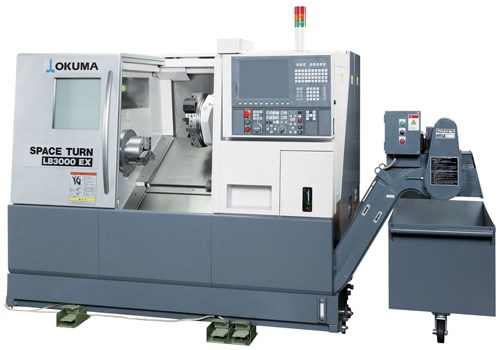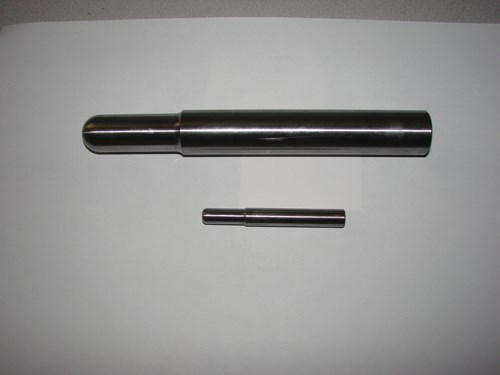Increasing Business with Hard Turning
By gaining experience in hard turning, a shop adds to its arsenal a cost-effective alternative to grinding, opening doors to new opportunities.
The most common draw to hard turning is the reduction in the need for grinding operations. With the ability to repeatedly turn parts that are harder than 45 Rc, a shop can save countless hours of setup and production time. But hard turning carries with it a certain intimidation factor. Shops often underestimate their machines’ capabilities or overestimate the complexity of the hard turning process, passing up opportunities that could lead to new business.
Hard Turning Principles
When a shop begins to add hard turning to its capabilities, it should be prepared for a bit of a learning curve. But generally, hard turning follows the same principles as typical turning operations. Because grinding requires a different set of skills and experience that many machinists do not have, hard turning may be a more natural fit anyway.
When compared with grinding, hard turning can offer a number of cost advantages. The most obvious might be the ability to complete the part on existing equipment, without purchasing a grinding machine, or worse yet, multiple grinding machines to perform the operations a single turning center may be capable of.
Because a turning center can complete ID turning, OD turning, taper turning and grooving in a single chucking, it can provide more consistent accuracy of squareness, concentricity and straightness than grinding operations. This capability also has a big impact on cycle time and setup time.
Hard turning has its limitations. Knowing the applications that are appropriate for hard turning versus when grinding might be the better option takes some experience. But if applied correctly, with the right machine and tooling, hard turning can be the ticket to significant savings and new business.
Applying the Technology
The company motto for one shop in South Lyon, Mich., is, “We can machine anything.” Michigan CNC Tool seems to have selected these words wisely based on its willingness to hard turn anything. The company first opened its doors in November 2007, precisely at the start of the recession. Perhaps that timing may seem unfortunate, but it has actually paid off for this hard turning specialist.
The company has doubled its sales each year that it has been in business, particularly by jumping on jobs that were abandoned by other companies, either because they were no longer in business or they elected to move away from the then-struggling automotive industry. Almost all of Michigan CNC Tool’s customers are in the automotive industry, serving companies such as GM and Chrysler, as well as Tier 1 suppliers that support the Big Three. They also do some work for spray equipment, but even that is typically used in the automotive market as well as other areas.
One of the shop’s strengths is its ability to hard turn parts. “We always prefer to hard turn, and we win jobs because we can,” says John Dziuban, company president. “Although we still grind a small number of parts on occasion, hard turning is faster and holds tolerances so much better.” The company uses two Okuma LB15 lathes for all of its turning work. Mr. Dziuban says he purchased these machines used when he started the business, but points out that they are well maintained and can handle the workload quite well because of their rigidity and heavy base.
The company works with a range of materials, from S5, S7 and O1 to D2, M2, and even some carbide. “Carbide isn’t our favorite,” Mr. Dziuban says. “But we’ve shown we can be successful with it.” Clearly, some parts bring tougher challenges than others.
One series of toolholders that the company machines, with sizes ranging from ½-inch to 1-inch diameter (and metric sizes close to the same range), is only about 45 Rc. In less than 25 seconds, the operator does a rough cut and a finish cut. But Mr. Dziuban says each part would take about 5 minutes to grind.
A more difficult part is a cutoff wheel made from 63Rc D2. Functioning in a similar way as a pipe cutter, it is used to cut the tubing within a car shock. Grinding the part would require multiple operations, handling diameters between centers, then grinding angles on both sides of the wheel as well as a radius on the outer edge. Now the part is turned in one setup—a higher quality part in far less time.
“Many of the parts we make we would have had to grind in the past,” Mr. Dziuban says. “And they would have required a variety of grinding operations, from surface grinding to form grinding to ID grinding. A typical process might involve rough turning, heat treating, then grinding. Being able to hard turn, though, saves a lot of time.”
Mr. Dziuban makes it clear that tooling is more expensive with hard turning, but that expense is more than accounted for in the time savings. Choosing the best tooling for a job is another important element to successful hard turning. Mr. Dziuban and his shop foreman both have a strong tooling background, but they still often turn to their supplier for answers. “Gary Mobarak, who is now retired from Valenite but still helps us out, has more experience than anyone in the business,” Mr. Dziuban says. “He’s shown us just how hard you can actually turn with carbide before you have to switch to CBN, when you have the right machine.”
Successful Hard Turning
Hard turning does not need to be hard to do. With the right equipment and tooling, and an understanding of the requirements of the job, the process is relatively straightforward. According to Larry Schwartz, chief strategy officer at Okuma America Corporation, “When considering hard turning, the first thing a shop should do is take a look at the equipment it is considering hard turning on.” He stresses that the machine’s thermal stability is critical to success because hard turning generates a tremendous amount of heat. Therefore, chip flow and coolant flow are also critical.
The construction of the way systems makes a difference as well: Boxways are preferred because of stability. Speed is not the key here; rather, rigidity will determine whether or not hard turning is feasible. The construction of the way sealing system will have a big impact. Most hard turning metals are extremely abrasive, so a double wiper system is beneficial, as well as positive airflow from the internal components, such as turrets and slides.
“Understanding that tool wear can be excessive, it’s important to select the appropriate cutting tools to ensure that the appropriate surface feed can be maintained,” Mr. Schwartz says. An adaptive control system can enhance the understanding of tool life and the ability to interact with inspection devices, and the machine tool control offsets are beneficial in dealing with tool wear and part distortion. “In most cases, hard turning is intended to replace grinding. Although it’s faster, the potential issues of holding tight tolerances and surface finishes should be considered in both tool geometry and inspection methods.”
Hard turning has the potential to expose a shop to difficulties with interrupted cuts, but the type of cutting tools used in the job has a big impact. In applications involving a keyway slot, for example, because the slot tends to break down a carbide insert, a shop might choose to grind instead to avoid the problem. In hard turning, any bouncing at all is likely to fracture the inserts, so machine tool rigidity and choosing the right inserts is vital to the success of the operation.
According to Mr. Schwartz, the top considerations for hard turning, beyond machine rigidity and tooling, involve understanding the machine’s capabilities, repeatability and positioning accuracies and recognizing the geometry of the workpiece and the areas that require hard turning. “It’s impossible to maintain tolerances beyond a certain length,” he says. “A foot-long shaft, for instance, couldn’t be held to 2 tenths. The tool would wear out. If it’s an inch, though, it’s not a problem.”
Optimizing the tool and tool life for hard turning typically involves trial and error. But starting with the right equipment increases the odds of achieving the objective more easily. As Mr. Schwartz explains, “An old machine that is not maintained will not provide the desired results. The condition of the machine tool is critical to the success of hard turning.” So how do you know when you are successful? Mr. Schwartz says, “When you make a good part.”
The Latest
Michigan CNC Tool continues to have success with its LB15 machines, but Okuma’s latest models offer even more capabilities to help shops with hard turning. The Okuma machine now most commonly used for hard turning is the LB-EX series. Many sizes and configurations of this machine are available and can include M, Y and W functionality.
The horizontal CNC lathes are designed for speed, accuracy and flexibility in the two-axis category, with rigid and thermal-friendly construction targeting hard turning operations. With a compact, reluctance (PREX) motor, the machine is built for strength and accuracy with high rotation speed, horsepower and torque. The thermal active stabilizer casting and spindle (TAS-C, TAS-S) automatically compensates for thermal deformation, achieving machining dimensional change of less than 7 microns on the diameter, even from a cold start.
To fit diverse application requirements, the series is engineered with flexibility in mind. Multiple bed and spindle sizes are available with almost 70 option variations, including milling (M), subspindle (W) and Y-axis capabilities. All models feature the operator-friendly THINC-OSP control—a true PC, Windows-based platform with open architecture, plug-and-work USB capability and 40 GB of memory. This control facilitates the connection to peripheral equipment and use of other machine tool accessories, improving productivity and data gathering.
Related Content
PMTS 2023 Product Preview: High-Volume Turning
Learn about some of the latest high-volume turning solutions that will be on display at PMTS 2023.
Read MoreThe Control’s Role in Machining Complex Parts
This company that produces medical implants finds value in the CNC for its turn-mill equipment that helps speed setups and simplify programming when producing intricate parts complete.
Read MoreDigitalization and Done-In-One Reign Supreme at BIEMH 2024
European manufacturers may have a different balance of markets than their U.S. counterparts, but the practical challenges they must overcome are often similar — as are the solutions.
Read MoreGetting More Production From Swiss Turning Centers
Buying a new CNC Swiss turning center is a substantial investment. For the best return, look closely for capabilities that enable the best utilization of the machine.
Read MoreRead Next
Getting the Most Out of Hard Turning
Traditionally, production of most parts made from hard or hardened materials, defined as those at or more than 45 HRc, required dedicated grinding equipment and processes.
Read MoreA Tooling Workshop Worth a Visit
Marubeni Citizen-Cincom’s tooling and accessory workshop offers a chance to learn more about ancillary devices that can boost machining efficiency and capability.
Read More5 Aspects of PMTS I Appreciate
The three-day edition of the 2025 Precision Machining Technology Show kicks off at the start of April. I’ll be there, and here are some reasons why.
Read More











.jpg;maxWidth=300;quality=90)



.jpg;maxWidth=300;quality=90)









